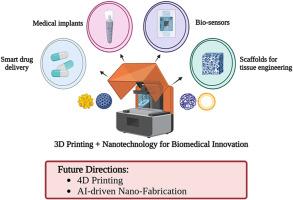Advanced 3D printing and multiscale technologies (nano to macro) for personalized biomedical applications
Q1 Computer Science
引用次数: 0
Abstract
The combination of 3D printing and nanotechnology is remodeling the field of biomedical innovation, opening up unprecedented levels of precision, personalization, and function in health care. 3D printing provides the capacity to print complex, patient-specific constructs, and nanotechnology extends this with dynamic biological interactions at the molecular scale to create smart implants, responsive drug delivery devices, and regenerative tissue scaffolds. This merging not only increases mechanical and biological compatibility but also encourages the development of multifunctional devices to monitor in real time, to treat selectively, and to exhibit bio responsive behaviour. Examples ranging from 3D-bioprinted organs to nanoengineered scaffolds and smart diagnostic biosensors show the ability to solve persistent organ transplantation, cancer therapy, and chronic disease management challenges. In addition, breakthroughs such as 4D printing and AI-driven nano-bio fabrication will be pushing the boundaries further by creating patient-driven, self-adaptive therapeutic platforms. But still, large technical, regulatory, and ethical hurdles have to be crossed in order to integrate on a large scale in a clinical manner. Nevertheless, synergistic convergence of nanotechnology and additive manufacturing bodes well for a shift toward highly personalized, predictive, and effective medical treatments. This review discusses the revolutionary contribution of 3D printing nanotechnology in reframing the future of medicine with focus on the pressing need for an interdisciplinary team approach to realize its full capability. The epoch of tailoring personalized therapies to the molecular level is no longer an elusive vision but a swiftly realising expectation capable of radically redefining the delivery and outcomes of care at a worldwide scale.

用于个性化生物医学应用的先进3D打印和多尺度技术(纳米到宏观)
3D打印和纳米技术的结合正在重塑生物医学创新领域,在医疗保健领域开创了前所未有的精度、个性化和功能水平。3D打印提供了打印复杂的、患者特异性结构的能力,纳米技术通过分子尺度上的动态生物相互作用扩展了这一点,以创造智能植入物、反应性药物输送装置和再生组织支架。这种合并不仅增加了机械和生物相容性,而且鼓励了多功能设备的发展,以实时监测,选择性治疗,并表现出生物反应行为。从3d生物打印器官到纳米工程支架和智能诊断生物传感器的例子显示了解决持久性器官移植、癌症治疗和慢性疾病管理挑战的能力。此外,4D打印和人工智能驱动的纳米生物制造等突破将进一步推动患者驱动、自适应治疗平台的发展。但是,为了在临床中进行大规模的整合,还需要跨越巨大的技术、监管和伦理障碍。然而,纳米技术和增材制造的协同融合预示着高度个性化、可预测和有效的医疗手段的转变。这篇综述讨论了3D打印纳米技术在重塑医学未来方面的革命性贡献,重点是迫切需要一个跨学科的团队方法来实现其全部能力。从分子水平定制个性化治疗的时代不再是一个难以捉摸的愿景,而是一个迅速实现的期望,能够在全球范围内从根本上重新定义护理的交付和结果。
本文章由计算机程序翻译,如有差异,请以英文原文为准。
求助全文
约1分钟内获得全文
求助全文
来源期刊

Bioprinting
Computer Science-Computer Science Applications
CiteScore
11.50
自引率
0.00%
发文量
72
审稿时长
68 days
期刊介绍:
Bioprinting is a broad-spectrum, multidisciplinary journal that covers all aspects of 3D fabrication technology involving biological tissues, organs and cells for medical and biotechnology applications. Topics covered include nanomaterials, biomaterials, scaffolds, 3D printing technology, imaging and CAD/CAM software and hardware, post-printing bioreactor maturation, cell and biological factor patterning, biofabrication, tissue engineering and other applications of 3D bioprinting technology. Bioprinting publishes research reports describing novel results with high clinical significance in all areas of 3D bioprinting research. Bioprinting issues contain a wide variety of review and analysis articles covering topics relevant to 3D bioprinting ranging from basic biological, material and technical advances to pre-clinical and clinical applications of 3D bioprinting.
 求助内容:
求助内容: 应助结果提醒方式:
应助结果提醒方式:


